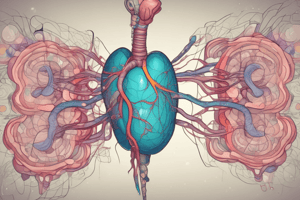Podcast
Questions and Answers
¿Cuál de las siguientes hormonas inhibe la liberación de hormona del crecimiento?
¿Cuál de las siguientes hormonas inhibe la liberación de hormona del crecimiento?
- GHRH
- Ghrelin
- ACTH
- Somatostatina (correct)
¿Qué sistema porta las hormonas del hipotálamo a la glándula pituitaria?
¿Qué sistema porta las hormonas del hipotálamo a la glándula pituitaria?
- Sistema endocrino
- Sistema nervioso central
- Sistema hipotalámico-pituitario
- Sistema hipotalámico-pituitario-portal (correct)
¿Cuál de las siguientes hormonas es producida por la glándula pituitaria y estimula la liberación de glucocorticoides por la corteza adrenal?
¿Cuál de las siguientes hormonas es producida por la glándula pituitaria y estimula la liberación de glucocorticoides por la corteza adrenal?
- Hormona adrenocorticótropa (correct)
- Hormona del crecimiento
- Hormona tiroidea estimulante
- Prolactina
¿Qué hormona es estimulada por la ghrelin y el GHRH?
¿Qué hormona es estimulada por la ghrelin y el GHRH?
¿Qué región del cerebro produce hormonas que controlan la función de la glándula pituitaria?
¿Qué región del cerebro produce hormonas que controlan la función de la glándula pituitaria?
Which of these options are correct? (Select all that apply)
Which of these options are correct? (Select all that apply)
This is an example statement that is true
This is an example statement that is true
Example question?
Example question?
The ______ barked
The ______ barked
Match the following programming languages with their primary usage:
Match the following programming languages with their primary usage:
Flashcards are hidden until you start studying
Study Notes
Hormone Regulation
- The pituitary gland is regulated by the hypothalamus, a region of the brain that produces releasing and inhibiting hormones to control pituitary function.
- The hypothalamus releases hormones into the hypothalamic-pituitary portal system, which carries them to the pituitary gland.
- The pituitary gland responds to these hormones by releasing or inhibiting the release of its own hormones.
Growth Hormone (GH)
- Produced by the anterior pituitary gland
- Stimulates growth and cell reproduction
- Regulates metabolism, particularly in children and adolescents
- Released in a pulsatile manner, with peaks during sleep and exercise
- Inhibited by somatostatin (released by the hypothalamus)
- Stimulated by growth hormone-releasing hormone (GHRH) and ghrelin
Adrenocorticotropic Hormone (ACTH)
- Produced by the anterior pituitary gland
- Stimulates the adrenal cortex to release glucocorticoids (e.g. cortisol)
- Regulates response to stress, inflammation, and immune response
- Released in response to corticotropin-releasing hormone (CRH) from the hypothalamus
- Inhibited by cortisol (negative feedback loop)
Thyroid-stimulating Hormone (TSH)
- Produced by the anterior pituitary gland
- Stimulates the thyroid gland to release thyroid hormones (T3 and T4)
- Regulates metabolism, growth, and development
- Released in response to thyrotropin-releasing hormone (TRH) from the hypothalamus
- Inhibited by thyroid hormones (negative feedback loop)
Hypothalamic-pituitary Axis
- A complex system of hormonal interactions between the hypothalamus, pituitary gland, and target endocrine glands
- The hypothalamus releases hormones that stimulate or inhibit the pituitary gland, which in turn regulates the release of hormones from target endocrine glands
- Examples of hypothalamic-pituitary axes include the:
- Hypothalamic-pituitary-adrenal (HPA) axis (regulating stress response)
- Hypothalamic-pituitary-thyroid (HPT) axis (regulating metabolism)
- Hypothalamic-pituitary-growth hormone (HPGH) axis (regulating growth and development)
Regulación Hormonal
- La glándula pituitaria es regulada por el hipotálamo, una región del cerebro que produce hormonas liberadoras e inhibidoras para controlar la función pituitaria.
- El hipotálamo libera hormonas en el sistema portal hipotálamo-hipofisario, que las lleva a la glándula pituitaria.
- La glándula pituitaria responde a estas hormonas liberando o inhibiendo la liberación de sus propias hormonas.
Hormona del Crecimiento (GH)
- Producida por la glándula pituitaria anterior
- Estimula el crecimiento y la reproducción celular
- Regula el metabolismo, particularmente en niños y adolescentes
- Se libera de manera pulsátil, con picos durante el sueño y el ejercicio
- Inhibida por la somatostatina (liberada por el hipotálamo)
- Estimulada por la hormona liberadora de la hormona del crecimiento (GHRH) y la grelina
Hormona Adrenocorticótropa (ACTH)
- Producida por la glándula pituitaria anterior
- Estimula la corteza adrenal para liberar glucocorticoides (por ejemplo, cortisol)
- Regula la respuesta al estrés, la inflamación y la respuesta inmune
- Se libera en respuesta a la hormona liberadora de corticotropina (CRH) del hipotálamo
- Inhibida por el cortisol (bucle de retroalimentación negativa)
Hormona Estimuladora del Tiroides (TSH)
- Producida por la glándula pituitaria anterior
- Estimula la glándula tiroidea para liberar hormonas tiroideas (T3 y T4)
- Regula el metabolismo, el crecimiento y el desarrollo
- Se libera en respuesta a la hormona liberadora de tiroidea (TRH) del hipotálamo
- Inhibida por las hormonas tiroideas (bucle de retroalimentación negativa)
Eje Hipotálamo-Pituitario
- Un sistema complejo de interacciones hormonales entre el hipotálamo, la glándula pituitaria y las glándulas endocrinas blancas
- El hipotálamo libera hormonas que estimulan o inhiben la glándula pituitaria, que a su vez regula la liberación de hormonas de las glándulas endocrinas blancas
- Ejemplos de ejes hipotálamo-pituitario incluyen el:
- Eje hipotálamo-pituitario-adrenal (HPA) (regulando la respuesta al estrés)
- Eje hipotálamo-pituitario-tiroideo (HPT) (regulando el metabolismo)
- Eje hipotálamo-pituitario-hormona del crecimiento (HPGH) (regulando el crecimiento y el desarrollo)
Studying That Suits You
Use AI to generate personalized quizzes and flashcards to suit your learning preferences.




